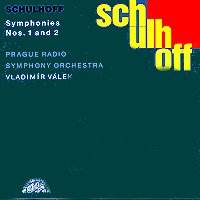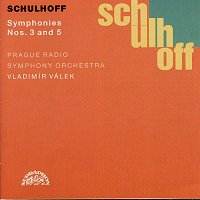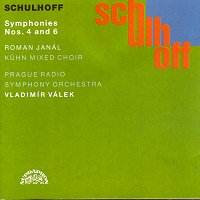| Erwin SCHULHOFF (1894-1942) The Six Symphonies Symphonies No 1 and No 2 Recorded Prague, September 1993 (No 2) and May 1994 (No 1) AmazonUK AmazonUS Amazon recommendations Symphonies No 3 and No 5 Recorded Prague, June 1994 (No 3) and November 1994 (No 5) AmazonUK AmazonUS Amazon recommendations Symphonies No 4 and No 6 Recorded Prague, June 1997 AmazonUK AmazonUS Amazon recommendations Kuhn Mixed Choir (Symphony No 6 only) Prague Radio Symphony Orchestra Vladimir Valek |
|
|
The six completed symphonies of Schulhoff - two others were sketched in prison but never completed - trace his journey from pseudo-orientalism and orchestral indulgence to a kind of Socialist Realism. The First is prodigal in orchestral effects, the Second a kind of Mozartian retrenchment, the Third is the first to explore a new seriousness and is the pattern for the final three symphonies which may, together, be seen as a testament to his political engagement. The Sixth and last even models itself explicitly on Beethoven's Ninth symphony and its choral finale is a ringing cry of defiance, orchestrated in 1941, the year before Schulhoff's death in a Bavarian camp.
But in 1925 Schulhoff was writing conscious orientalisms, striving for a Slavic language susceptible to the impress of his youthful imagination. This jeux d'esprit - the First - is in truth not much of a symphony but it strives for and achieves a dramatic, surging almost cinematic power which can be convulsively involving. From a rippling woodwind introduction we are introduced to Schulhoff's orchestral palette, much of which he retained in one form or another until the end of his life - a liking for sectional writing, heavy reliance on drum tattoos, layered brass writing, frequently explosive and fanfare-laden, march themes, and small four-note ideas which are developed and harmonised and relentlessly exploited. The First Symphony employs the pentatonic scale in its scherzoso introduction, a chugging Janacek-like momentum, and crazily dramatic orchestral surges. Scheherazade is a model for Schulhoff's sonority in the second movement - unsurprisingly given his Slavic intentions with this work - but overall there is a sense of prolixity and unrestrained imagination, notwithstanding the truly amusing oriental dance band incident - if such can be imagined - at 5'41 into the movement. Jagged, unsettled, almost obsessively repeated, these features of Schulhoff's were embedded seemingly from the beginning though here they are mostly benign and transformed into a shatteringly intense, inflated finale.
After the almost grotesque exuberance of his First Symphony Schulhoff accepted a commission to make arrangements of symphonies by Jan and Karel Stamic and to write a symphony of his own. The result was an eighteen-minute four-movement piece that ranged decorously from Mozartian elegance to strumming-banjo-and-saxophone blues. The idiom is at once backward and forward looking and an acknowledgment by the composer that his earlier symphony's convulsive sonorities could be neither sustained nor indulged in the same way. If this is neo-classicism it is not of the Martinu stamp - Schulhoff's almost exact contemporary was as western looking as Schulhoff was eastern - and Martinu's aesthetic would hardly have embraced the brazen contradictions Schulhoff revels in. Nevertheless Schulhoff's excursion into Le Jazz is poised disconcertingly somewhere between Milhaud and Walton and is presumably his idea of a Haydnesque folk dance translated into a contemporary context. A spruce classical finale wraps up the work - light-hearted woodwinds, clean-limbed strings. In that sense the Second is almost the inverse of the First Symphony - in which Schulhoff subjects himself to constraints of sonority and instrumentation to try to achieve a medium suitable for his remarkable orchestral gifts.
A new emphasis to this development was his crucial 1933 visit to Moscow and his subsequent exposure to Socialist Realism. As he wrote, rather forbiddingly, "My music is not dreamy, it contains neither decadent lyricism nor outbursts of hysteria. It has become hard, relentless and uncompromising." What remains true is that his final symphonies gain orchestral mastery at the expense of colour and variety. Schulhoff exploits his penchant for a four note motif at the beginning of the symphony; for all the starkness it is a characteristically Schulhoffian technique and subsequent sweeping string lines, brusque drum tattoos and march themes equally so. The work is, according to taste, idealistic, bombastic and unvaried but it features much beautiful use of layered brass - Schulhoff was a superb and much admired pianist and wrote uncommonly well for trumpets and trombones - as well as a second movement of real dramatic and elegiac flexibility. It certainly marked a new beginning in his political and musical life - a renunciation of the past and the embracing of an overwhelming ideological aesthetic that was to mark his final decade.
The last three symphonies show Schulhoff attempting to refine still further the Socialist Realist ideal. The symphonies are, in that sense, of a kind; their texture can be suffocatingly intense and they are single-minded in their adherence to their models. The Fourth was inspired by the Spanish Civil War and set Lysohorsky's contemporary poem, 'Dying in Madrid', for solo baritone, a role taken here by the experienced Roman Janal. The opening insistent disquieting march - the whole first movement lasting less than four minutes - is a device Schulhoff was to return to again. The hamstrung moderato - with a four-note theme insistently examined and harmonised - leads to an andante which steadfastly refuses the consolation of lyricism and which bears out Schulhoff's own words on the subject. Glowering brass begin the finale, with trombones and trumpets never quite ideally balanced with the strings in this recording, ending with a somewhat indeterminate six-note figure.
The Fifth Symphony was completed in 1939. As with all the last four symphonies it was only performed posthumously. With no chance of a performance in occupied Czechoslovakia Schulhoff strips down his material yet further. A first movement single theme is pushed to a climax, constantly repeated. A slow movement strangely reminiscent of Bliss' orchestral writing for strings at about this time leads to a driving, passionate scherzo and a finale of monumental variation form. A fugal section - in heavy boots - gathers itself in momentum and exploits subtle gradations to maximum effect. The last completed symphony, the Sixth, the "Freedom Symphony" was orchestrated in 1941. Here, finally, Schulhoff's many technical devices are allied to his transcendental belief in Beethoven and in his ultimate belief in liberty. Similar procedures are adhered to in the introduction - the familiar drum tattoos, brass motifs, four-note themes, fanfares, processionals. The polyphonic funeral march adagio never congeals into orchestral self-pity. Indeed it is one of the virtues of his now refined aesthetic that Schulhoff can maintain a harmonically elaborate movement allied to uplifting thematic material. The folk tinged third movement - a wispy light dance - is an affecting reminiscence of Schulhoff's past. Meanwhile the orchestra introduces the Choral finale and the chorus take up Adalbert von Chamisso's poem Slaves in an indomitable conclusion to the work.
This cycle of the symphonies is part of the complete Supraphon Schulhoff edition. It is entirely worthy of the undertaking. The Prague Radio Symphony Orchestra plays with technical excellence and security. The strings are appropriately lean, the brass magnificent; all sections of the orchestra respond to Schulhoff's insistent demands with great skill. Vladimir Valek conducts with superb control; some small matters of balance aside, and the lack of texts, this is an invaluable series of discs that reveal Schulhoff's struggles to accommodate belief with form and that shows his final triumph in the face of adversity, a triumph here shared by orchestra and conductor and by Supraphon itself.
Jonathan Woolf


